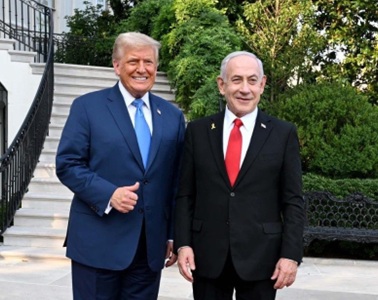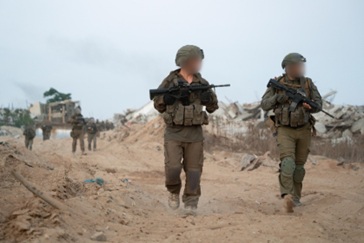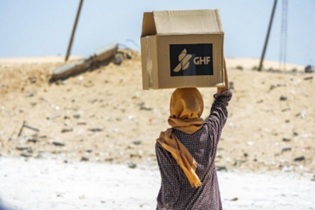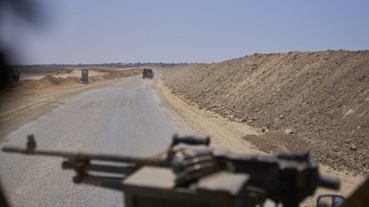Difficult to know what’s what. Or what will be. But at every step there are decisions to be made.
~~~~~~~~~~
Trump is saying he thinks maybe there will be a ceasefire in Gaza by the end of the week. But wait! Didn’t he say this last week? And even before? Keep reading.
After Trump and Bibi met at the White House twice last week, to many analysts what seemed most important was what was not said: There were no joint announcements, no press conferences. This suggested that the meetings were not for show – that serious business was on the table with regard to Iran and Hamas, and likely Syria as well.
https://www.jpost.com/international/article-860395

The expectation at that point was that something of significance would emerge from these meetings. But rather than seeing a definitive policy shift, we have been left feeling as if we were going in circles. The sense of déjà vu has been persistent: Hey, didn’t we hear that last week?
~~~~~~~~~~
The image generated at the time of these meetings was one of two leaders in full sync: presumably they held each other in deep regard, and there was no daylight between them. I have no doubt that some warm feelings between the two do exist: it is not all a mirage. Netanyahu tells it true when he says Trump is the most pro-Israel president we’ve ever had.
Yet, if we look beneath the façade, we find that major differences remain in terms of the approach to be taken with Hamas and with Iran. We should not be surprised that the meetings did not bring consensus on these major issues. How could they? Trump remains the advocate of deals. Thus his eagerness for a ceasefire between Israel and Hamas, one which might be – or in truth, he hopes would be – transformed into something permanent.
Netanyahu on the other hand understands that when confronting the evil of jihadists, no deal will suffice. Hamas must be brought low – disarmed, denied the ability to rule in Gaza, and rendered incapable of attacking Israelis again.
I have saluted our prime minister for standing firm on what he sees as an existential issue. He has compromised several times in the negotiations, but there has been a presumption that there was a point beyond which he would not compromise. (I will get to this.)
I have also saluted Trump for all he has done for Israel. At present, he has not taken a stand, at least publicly, that would make it impossible for us to continue fighting – has not, for example, held back weaponry. And in the fact of the matter, we are fighting fiercely.
Two days ago, the Deputy Commander of IDF Battalion 420 said, “The enemy is becoming bolder, but we are working aggressively, using heavy fire, operating strongly, and trying to protect our more sensitive areas during attacks. Overall, we are performing very well in our missions.”
The missions involve the identification and destruction of terror tunnels and taking out of the Beit Hanoun Battalion.
https://www.israelnationalnews.com/news/411711

But we should not delude ourselves that there is no pressure. Without question, there is major pressure.
~~~~~~~~~~
The salient points in the off-again, on-again negotiations for a ceasefire:
The major issues of contention have been the degree of IDF withdrawal that would occur during a 60-day ceasefire, and the right of Israel to resume fighting after the ceasefire. Presumably negotiations on a permanent ceasefire would take place during the 60 days.
While confronting Hamas militarily in the field, we have had to confront the Hamas lies, which are persistent. They are masters at this, fighting Israel via propaganda as well as weapons. Unfortunately, a good part of the world buys their falsifications and fabrications. We are fighting a just existential war with great morality and yet are being broadly accused of genocide.
One of the reasons it has taken Israel so long to defeat Hamas is because the terrorist organization confiscated large portions of the humanitarian aid going into to Gaza, in order to strengthen its own terrorists and secure funds by re-selling the aid to the civilians for whom it had been intended in the first place.
When a new system was put in place managed by a US-based group called Gaza Humanitarian Foundation (GHF), Hamas was greatly irritated – because the new system was actually getting food to the civilians – and sought to sabotage it.

This past Monday, GHF announced that it had delivered 1.3 million meals to Gazans on that day, bringing the total to more than 74 million meals distributed since it began operations in late May.
“Distribution at all sites ran ‘smoothly’ and ensured ‘the protection of all civilians present’, the organization said.
“GHF also denied claims made in a July 11 statement from the U.N. human-rights office regarding the body’s ‘concerns’ about the number of ‘casualties of Palestinians seeking aid, tying them to GHF sites.’
“’These false and misleading stats come directly from the Hamas-controlled Gaza Health Ministry,’ the organization stated.“
GHF said that “the U.N.’s reliance and coordination with a terrorist organization to falsely smear our effort” was disturbing.
https://www.jns.org/ghf-delivers-1-3-million-meals-slams-false-misleading-un-report/
~~~~~~~~~~
In the course of negotiations, more than once Israel has submitted changes to the proposed deal under discussion in order to make it more palatable to Hamas. And we must ask then why Netanyahu would agree to a weakened position in order to secure a deal when Hamas was being typically rejectionist.
There are several aspects to this. One is the obligation our prime minister feels to secure the release of Israeli captives. A second is the pressure inside of Israel from families of the captives and those utilizing the issue to weaken Netanyahu. There has been a groundswell of street demonstrations, generating political pressure.
Lastly, there is the pressure from the US, which may well be the deciding factor.
With it all, my sense until now has been that there ultimately would be no ceasefire because the positions of Israel and Hamas were simply too far apart.
As recently as five days ago, Times of Israel, citing Palestinian Arab sources, reported: “While Israel agreed to ease some of its demands regarding the redeployment of its troops during the 60-day truce under discussion following US pressure, the new series of maps depicting the partial withdrawal of IDF troops was not sufficient to satisfy Hamas.”
~~~~~~~~~~
Today, as I write, there may be yet another proposal from Israel regarding deployment of the IDF in Gaza during a ceasefire. This was according to a report emanating from Egypt.
According to this report, which has not been officially confirmed, Israel has agreed to pull back from the Morag Corridor, a 12-kilometer route between Rafah and Khan Younis.

But wait! Israel had said the Morag Corridor was of critical importance. Are we seeing concessions that are not in Israel’s best interest as the result of pressure, specifically from Trump’s envoy Steve Witkoff?
Mindful though I am that less than a week ago I ran a video in which Bibi said there was no pressure from Trump, only coordination, I would suggest that the question I pose above may be rhetorical.
Hamas has reportedly accepted this new proposal. And apparently Witkoff is scheduled to arrive in this area next week with the expectation of announcing a ceasefire. (He had purposely stayed away until the ceasefire looked close.)
~~~~~~~~~~
For the record, this is not a done-deal yet, nor is anything official. Apparently, there are still issues that are not resolved. But the suspicion grows that Trump is going to get what he wants at all costs.
~~~~~~~~~~
While we must still wait for the final outcome here, my unease is enormous. This is, first, because it is apparent that – if there is a 60-day ceasefire – great pressure would be applied to get Israel to agree to a permanent ceasefire, which would leave Hamas standing. An article in the Jerusalem Post raised the question of whether Israel, having agreed to pull out of the Morag Corridor for a ceasefire, would be allowed to go back in “post-ceasefire.” Excuse me?
I have concerns about the degree to which Hamas would be able to strengthen during a ceasefire, especially as demands are being made by them for increased humanitarian aid to which the terrorists might again have access.
I am concerned about the degree to which Hamas – which has a propensity for this tactic – would booby-trap areas into which we might return after a pull back, thus taking the lives of more of our boys.
I am distressed because only half of the hostages who are still alive would be released. This might consign the remaining 10 who are alive to the agony of being permanently held by Hamas. No one knows which 10 would be released – their identities would be determined by Hamas. There are those – including some of the parents of hostages – who say we should hold out for a release of all the hostages at once.
Lastly, there is the greatly troubling issue of the release of terrorists from our prisons. As I write, I still have not seen figures and am left with the troublesome sense that it will be more or less a case of opening the prison doors and letting out large numbers.
See this video of 369 prisoners, most serving life sentences, who were released for three hostages during a previous deal. Some ratio! And how they are celebrated.
~~~~~~~~~~
I will table for now discussion of possible plans that Israel has for the residents of Gaza. They may become moot.
And I will come back as well to look at the situation in Syria and in Iran.
~~~~~~~~~~
I ask for prayers for all of Am Yisrael.
Pray for the wisdom and courage of our leaders.
Pray for the safety of our soldiers as they fight.
Pray for the recovery of all hostages.
~~~~~~~~~~
©Arlene Kushner. This material is produced by independent journalist Arlene Kushner. Permission is granted for it to be reproduced only with proper attribution.
